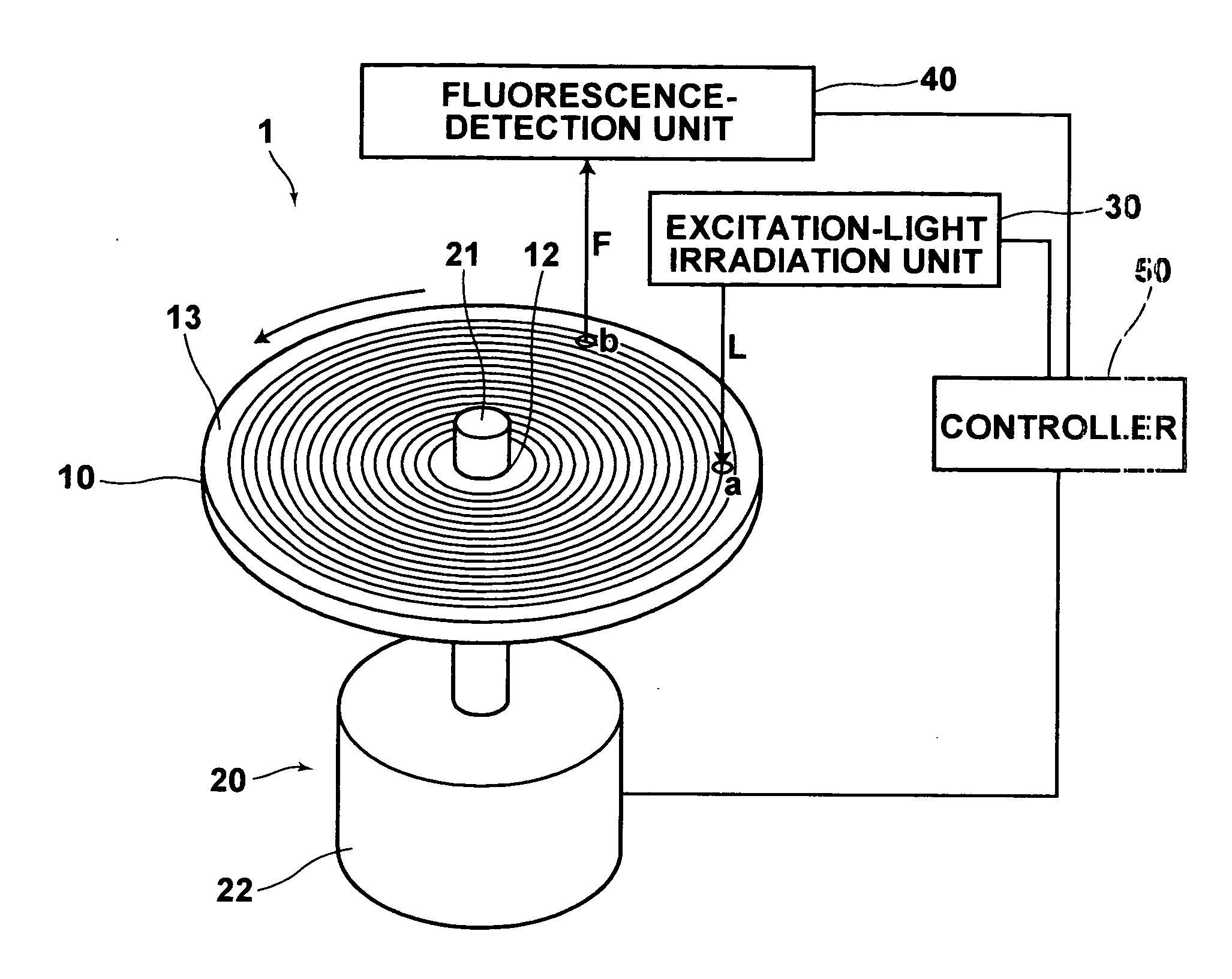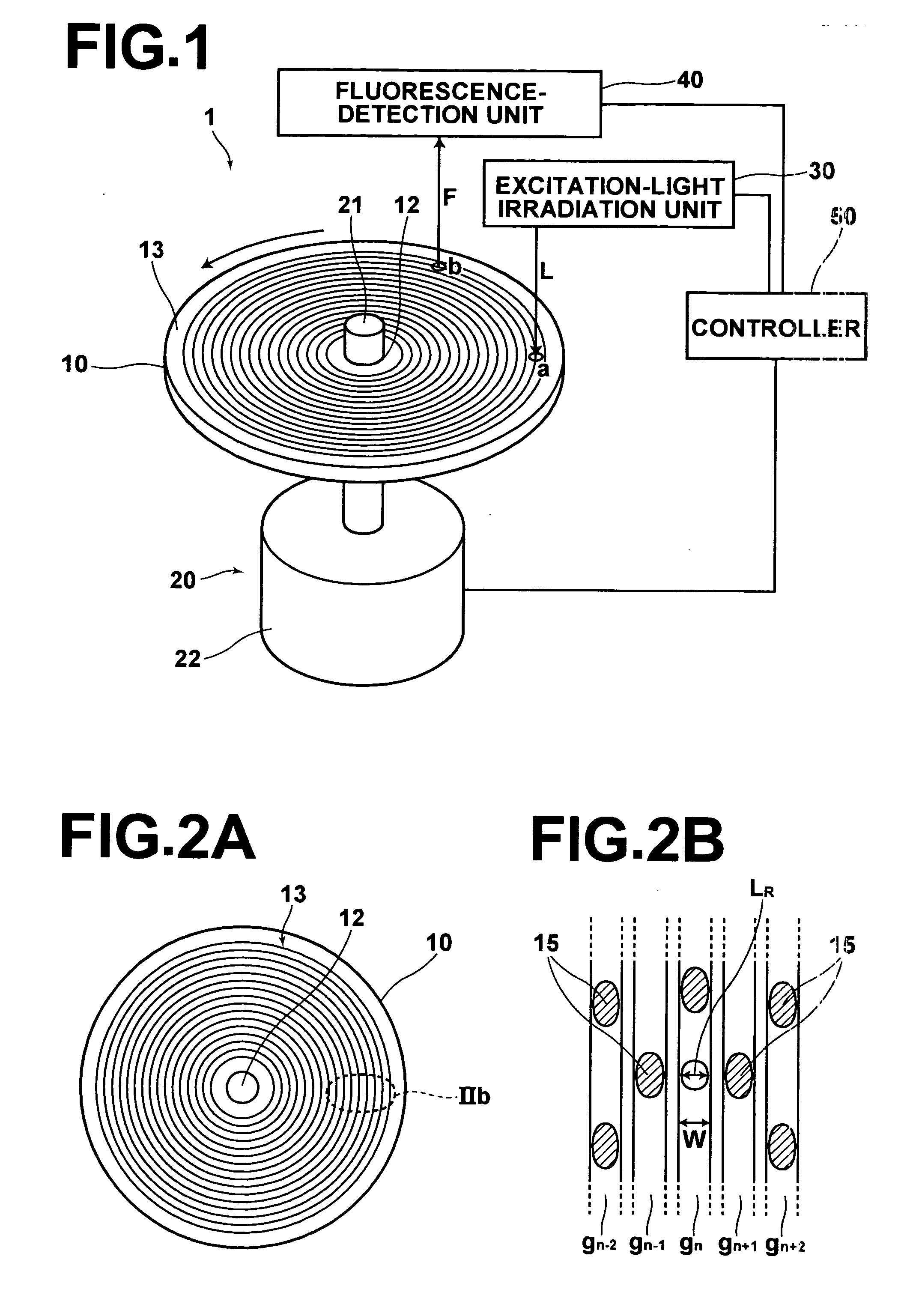Method and system for detecting fluorescence from microarray disk
a microarray disk and fluorescence detection technology, applied in fluorescence/phosphorescence, laboratory glassware, instruments, etc., can solve the problems of reducing the signal-to-noise ratio in the signal indicating, the difficulty of downsizing the above device, and the noise of excitation light, etc., to achieve high signal-to-noise ratio and high signal-to-noise ratio
- Summary
- Abstract
- Description
- Claims
- Application Information
AI Technical Summary
Benefits of technology
Problems solved by technology
Method used
Image
Examples
first embodiment
[0035]FIG. 1 is a diagram schematically illustrating a fluorescence detection system according to the first embodiment of the present invention.
[0036] As illustrated in FIG. 1, the fluorescence detection system 1 according to the first embodiment comprises a microarray disk 10, a rotation unit 20, an excitation-light irradiation unit 30, a fluorescence-detection unit 40, and a controller 50.
[0037] The microarray disk 10 is constituted by a rotatable substrate disk, where a surface of the microarray disk 10 includes a specimen-holding area, and fluorescence-labeled biological specimens are fixed on the specimen-holding area. The rotation unit 20 rotates the microarray disk 10. The excitation-light irradiation unit 30 irradiates each of the biological specimens (fixed on the microarray disk 10) with excitation light L. The fluorescence-detection unit 40 detects fluorescence F emitted from each of the biological specimens. The controller 50 controls the rotation unit 20, the excitati...
second embodiment
[0062]FIG. 4 is a diagram schematically illustrating a fluorescence detection system according to the second embodiment of the present invention.
[0063] The fluorescence detection system 2 according to the second embodiment is different from the fluorescence detection system 1 according to the first embodiment in that an excitation-light irradiation unit 35 and a fluorescence-detection unit 45 are integrally formed in an optical unit 60.
[0064] The optical unit 60 comprises a condensing lens 61 and a half mirror 62. The condensing lens 61 is arranged above the specimen-fixed side of the microarray disk 10, makes the excitation light L converge on each biological specimen, and collects fluorescence F emitted from the biological specimen. The half mirror 62 is arranged above the condensing lens 61, passes the fluorescence F, and reflects the excitation light L.
[0065] The optical unit 60 operates as follows.
[0066] The excitation light L is emitted from the laser diode 31, collimated ...
PUM
| Property | Measurement | Unit |
|---|---|---|
| diameter | aaaaa | aaaaa |
| diameter | aaaaa | aaaaa |
| angle | aaaaa | aaaaa |
Abstract
Description
Claims
Application Information
 Login to View More
Login to View More - R&D
- Intellectual Property
- Life Sciences
- Materials
- Tech Scout
- Unparalleled Data Quality
- Higher Quality Content
- 60% Fewer Hallucinations
Browse by: Latest US Patents, China's latest patents, Technical Efficacy Thesaurus, Application Domain, Technology Topic, Popular Technical Reports.
© 2025 PatSnap. All rights reserved.Legal|Privacy policy|Modern Slavery Act Transparency Statement|Sitemap|About US| Contact US: help@patsnap.com



